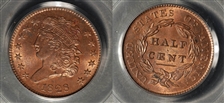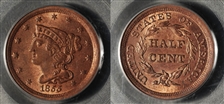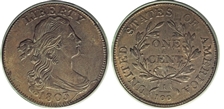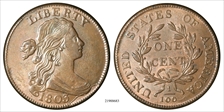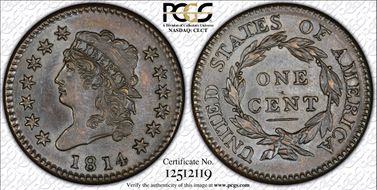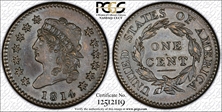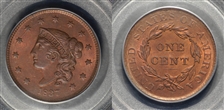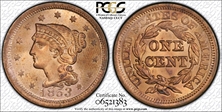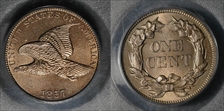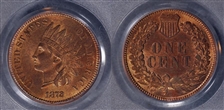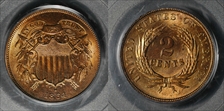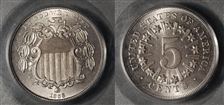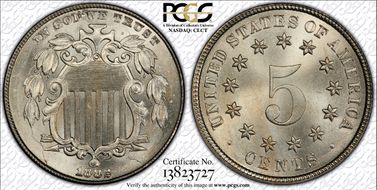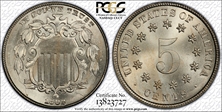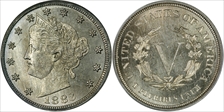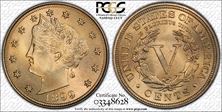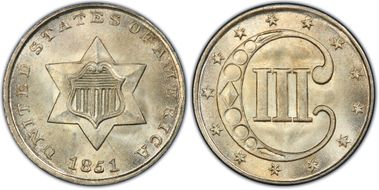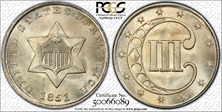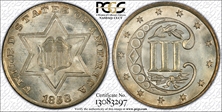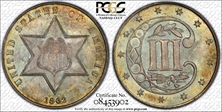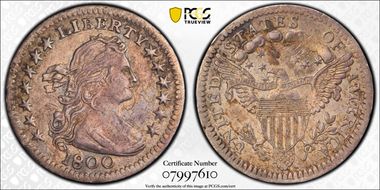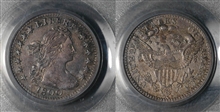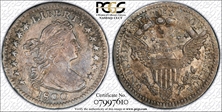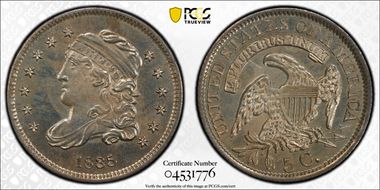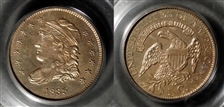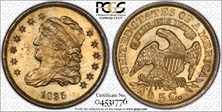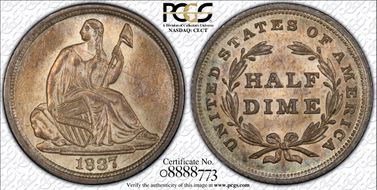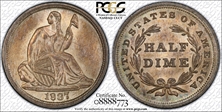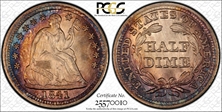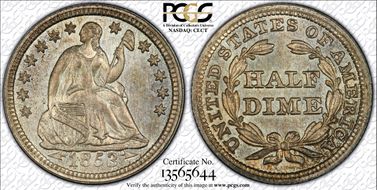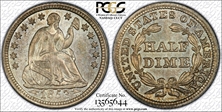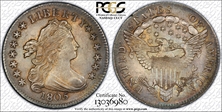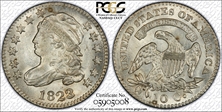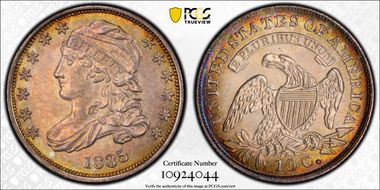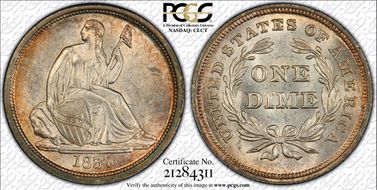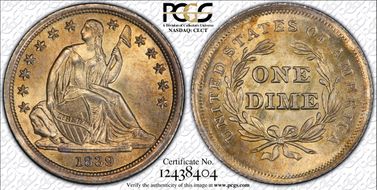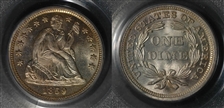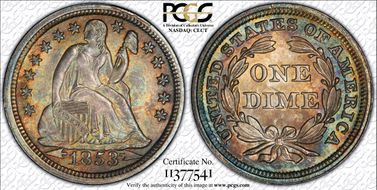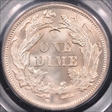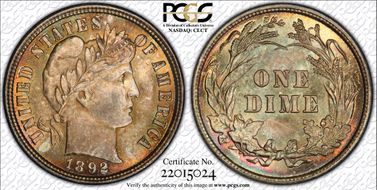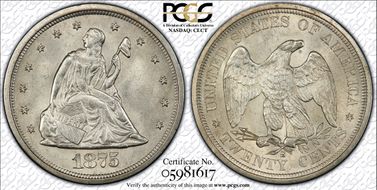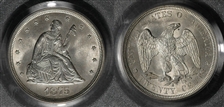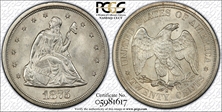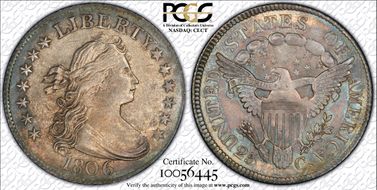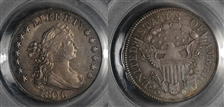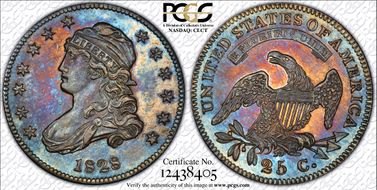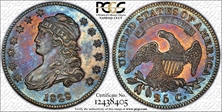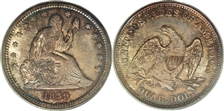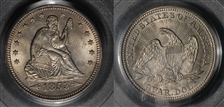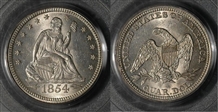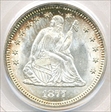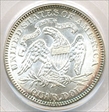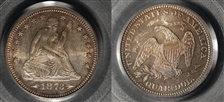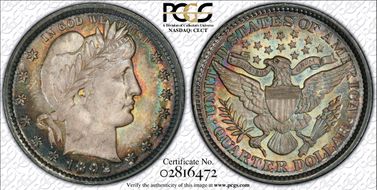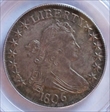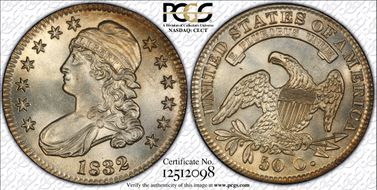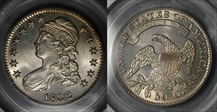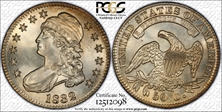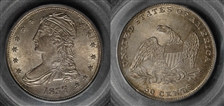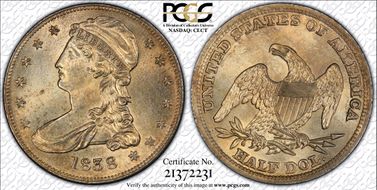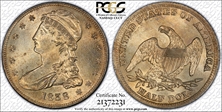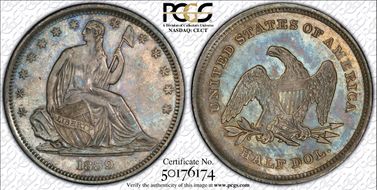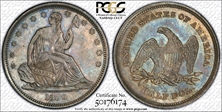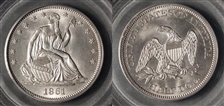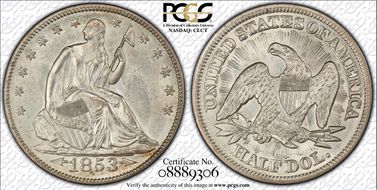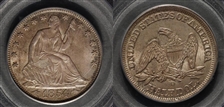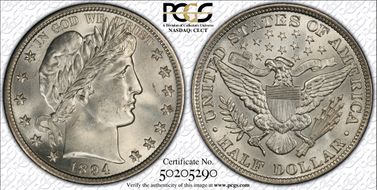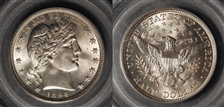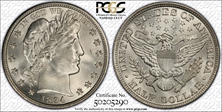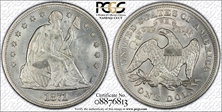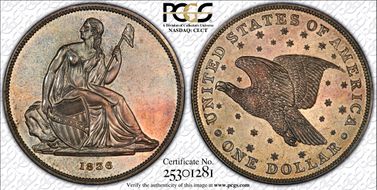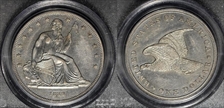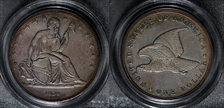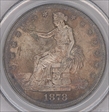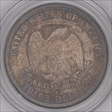Gobrecht's Raisinet Collection 的钱币相册
1806 1/2 C Large 6, Stems MS63RB B-4, C-4, R.1. Immediately distinguishable by a large, repunched 6 with the peak affixed to the base of Liberty's bust. Much faded mint-red color remains all over the coin. Most Uncirculated representatives of this variety trace back to the hoard of 1806 B-4 Half Cents that the Chapman brothers dispersed in 1906.
1806 1/2 C Large 6, Stems MS63RB B-4, C-4, R.1. Immediately distinguishable by a large, repunched 6 with the peak affixed to the base of Liberty's bust. Much faded mint-red color remains all over the coin. Most Uncirculated representatives of this variety trace back to the hoard of 1806 B-4 Half Cents that the Chapman brothers dispersed in 1906.
1828 1/2 C 13 Stars MS64 Red. C-3, B-2, R.1. This variety is attributed by: the low 2 in the date, repunching on star 7, the second S in STATES essentially even with the tip of the highest leaf, a defect that joins the left top of H in HALF to the above leaf, and a wreath spine that extends from the leaf point above HA. Orange mint luster enlivens well preserved surfaces, and a crisp strike has emboldened the design elements. A pleasing near-Gem half cent, housed in a green-label holder. Population: 6 in 64 Red, 1 finer (2/07). EAC 63. From The Temecula Collection, Part Two.
A gorgeous fire-red near Gem type coin that has nearly mark-free surfaces. The devices are very well struck, although portions of the dentils are softly brought up. Carbon is microscopic.
S-254, B-13, R.1, PQ. Breen Die State IV. Sheldon-254 is readily identified by the heavy die crack through the bust tip. This is a lustrous light chocolate-brown Draped Bust cent that has glimpses of faded Mint pumpkin-gold within the reverse legends. Minor strike-throughs distributed on the right obverse and on the upper right reverse quadrant are of mint origin, as is a small depression near the obverse rim at 8 o'clock. Contact is limited to faint ticks on the neck and on the reverse near 1 o'clock. Nicely struck, and a desirable type coin in such exemplary grade. EAC 53.
S-254, B-13, R.1, PQ. Breen Die State IV. Sheldon-254 is readily identified by the heavy die crack through the bust tip. This is a lustrous light chocolate-brown Draped Bust cent that has glimpses of faded Mint pumpkin-gold within the reverse legends. Minor strike-throughs distributed on the right obverse and on the upper right reverse quadrant are of mint origin, as is a small depression near the obverse rim at 8 o'clock. Contact is limited to faint ticks on the neck and on the reverse near 1 o'clock. Nicely struck, and a desirable type coin in such exemplary grade. EAC 53.
S-254, B-13, R.1, PQ. Breen Die State IV. Sheldon-254 is readily identified by the heavy die crack through the bust tip. This is a lustrous light chocolate-brown Draped Bust cent that has glimpses of faded Mint pumpkin-gold within the reverse legends. Minor strike-throughs distributed on the right obverse and on the upper right reverse quadrant are of mint origin, as is a small depression near the obverse rim at 8 o'clock. Contact is limited to faint ticks on the neck and on the reverse near 1 o'clock. Nicely struck, and a desirable type coin in such exemplary grade. EAC 53.
1814 1C Crosslet 4 MS63BN S-294, B-1, R.1. Only two die marriages are known for 1814 Cents, and each receives a separate Guide Book listing due to a different logotype on the 4. Traces of faded red color surround the legends and stars, while the fields and portrait exhibit steel-brown color. This well struck Large Cent has a nearly undisturbed obverse, and the reverse is also refreshingly clean. This is a relatively common Classic cent, but always of great importance to type collectors, as these pieces become scarce in XF and better grades.
1814 1C Crosslet 4 MS63BN S-294, B-1, R.1. Only two die marriages are known for 1814 Cents, and each receives a separate Guide Book listing due to a different logotype on the 4. Traces of faded red color surround the legends and stars, while the fields and portrait exhibit steel-brown color. This well struck Large Cent has a nearly undisturbed obverse, and the reverse is also refreshingly clean. This is a relatively common Classic cent, but always of great importance to type collectors, as these pieces become scarce in XF and better grades.
1837 1C Medium Letters MS65RB. N-6, Low R.2. The 3 in the date is low, and the left foot of the N in ONE is recut. An interesting example from a year in which the cent was the only copper denomination coined, this Gem cent has considerable original orange mint color.
1853 MS65RD. So firey red the coin almost looks like it was minted yesterday, with virtually no marks and only a slight partial fingerprint to justify this grade, as opposed to a higher one.
1853 MS65RD. So firey red the coin almost looks like it was minted yesterday, with virtually no marks and only a slight partial fingerprint to justify this grade, as opposed to a higher one.
1853 MS65RD. So firey red the coin almost looks like it was minted yesterday, with virtually no marks and only a slight partial fingerprint to justify this grade, as opposed to a higher one.
1857 Flying Eagle Cent, graded MS-65. Simply outstanding! This coin has a full strike and breathtaking eye appeal. It is a gem in every respect. The color is an even light nickel color with just a light contact marks above the Eagle's left wing. The reverse is nearly mark free. A superb coin. Pop 166; 15 finer in 66. Ex:The "Chiro" Collection. Eagle Eye Photo Seal.
1859 1C MS65. This is the first year of issue for the Indian Cent design by James Barton Longacre, and it is a one-year design type. The characteristic striking weaknesses which the Mint experienced during production of the Flying Eagle Cent prompted Mint Director Colonel James Ross Snowden to order designer/engraver James Longacre to prepare other cent designs, one of which would replace the Flying Eagle as of January 1, 1859. After reviewing various pattern cents, Snowden chose the Indian/laurel wreath combination because it was in lowest relief of all the candidates, striking up better than the others. This coin became the Indian Cent, which has been immensely popular with generations of collectors. With the Indian cent design as adopted on cents from 1860 through 1909 on the obverse, and the laurel wreath reverse that was only used in this year, the 1859 has proved to be a type coin of enduring popularity. Unfortunately for the Mint as well as modern collectors, this issue proved equally difficult to strike as its Flying Eagle predecessors. Many otherwise attractive coins are limited in grade by bluntness of detail over the date, denomination, feather tips, and diamonds. Not so the present Gem. Every feature is well brought up, and the smooth surfaces are devoid of any major distractions. This example is fully lustrous and sharply struck with exquisite golden-tan coloration.The premier delivery in 1859 totaled 36.4 million pieces, and they are distinct as being the only coins in this series with a laurel wreath enclosing the denomination ONE CENT on the reverse. The obverse has a profile of Liberty facing to the left, wearing a headdress consisting of nine broad feathers. The band on the headdress is inscribed with the word LIBERTY, and a ribbon hangs down near the neck, containing four decorative diamonds. A small raised die chip on Liberty's cheek identifies this obverse die. The reverse consists of a laurel wreath, open at the top, and tied by a ribbon at the bottom. This wreath encloses the denomination ONE CENT. The reverse die is well-made without any die defects.
Khaki-olive color cascades across both sides of this satiny Gem. Conditionally rare and ranked as one of the finest-known representatives of the date, one is unable to locate even the the most paltry of abrasions on this coin. Eagle Eye Photo Seal approved, with card of authenticity.
1864 2C Large Motto MS65RD. A fiery, very premium quality Gem of this important and widely collected odd denomination. Millions were struck of this first year issue, but full red Gems are anything but common. The surfaces of this coin display a vibrant and totally original orange-red color that barely shows just a whisper mellowing in the nearly 15 decades since its Civil War era origin. The mint red color is virtually undiminished by the passage of time, appearing today much as it did in 1864, the year Colonel Chivington massacred the Southern Cheyenne at Sand Creek. This unusual denomination was created to help fill the yawning gap in circulating coinage that resulted from the widespread hoarding of coins in the early 1860s. An historic issue designed by James Barton Longacre that is indelibly linked with the Civil War, the 1864 two cent piece is also the first U.S. coin to bear the motto IN GOD WE TRUST. The present example is the second and more commorn of the two varieties produced this year. The earlier Small Motto coins were prototypes and modified after only a few thousand were struck, with the motto enlarged on subsequent strikings. Far fewer of the Small Motto coins are seen today with full red color than of their Large Motto counterparts. Held back from an even higher grade only by light, scattered flyspecks, and uncommonly attractive even for the MS65 grade, this Large Motto Gem shows nearly full mint-red color. Both sides are intensely lustrous, with vivid crimson-orange color. All features show pinpoint striking definition, with with good detail to the highpoints. The lustrous and unabraded surfaces have no obtrusive contact marks, and only negligible carbon.
1868 3CN MS66. Well struck and untoned, with lustrous pearl-gray surfaces that are essentially unmarked on both sides. A splendid Premium Gem example of this conditionally scarce issue. Population: 25 in 66, 1 finer (2/07).(
1866 5C Rays MS65. A brilliant and lustrous Gem with a splendid strike and impressive preservation. The upper obverse has a forest of faint die cracks, as struck, while the reverse has wispy die cracks throughout the peripheral legends.
1882 5C MS66. Blazing luster is the hallmark of this exceptional, untoned Premium Gem. Spindly die cracks are noticeable on the obverse, as usual. A planchet flaw is observed on the upper obverse border, between D and W. Surface blemishes are nearly nonexistent. Population: 68 in 66, 4 finer (7/07).
1882 5C MS66. Blazing luster is the hallmark of this exceptional, untoned Premium Gem. Spindly die cracks are noticeable on the obverse, as usual. A planchet flaw is observed on the upper obverse border, between D and W. Surface blemishes are nearly nonexistent. Population: 68 in 66, 4 finer (7/07).
1883 No Cents MS66. Undoubtedly one of the most common type coins in all of U. S. numismatics, the 1883 No Cents nickel is easily located in all uncirculated grades, up to and including MS66. While it may be accurate to call the No Cents nickel a "common" coin, it is not often available and considering its status as a one-year type, it certainly is not overpriced in grades above MS65.
Blazing luster and light golden toning grace this unblemished Premium Gem. Well struck save for the usual blending on the left ear of corn.
Blazing luster and light golden toning grace this unblemished Premium Gem. Well struck save for the usual blending on the left ear of corn.
The strike is uncommonly sharp, since the shield is fully brought up, and the stars have crisp centers. Booming luster and gentle tan-gray toning provide further eye appeal. Only a wispy diagonal mark above the 51 in the date denies perfection.
The strike is uncommonly sharp, since the shield is fully brought up, and the stars have crisp centers. Booming luster and gentle tan-gray toning provide further eye appeal. Only a wispy diagonal mark above the 51 in the date denies perfection.
Light yellow toning surrounds the silver-gray centers of this satiny and choice near-gem. A clash mark from the C is visible at the top of the obverse. The surfaces are remarkably clean for the grade, and there is great eye appeal.
Light yellow toning surrounds the silver-gray centers of this satiny and choice near-gem. A clash mark from the C is visible at the top of the obverse. The surfaces are remarkably clean for the grade, and there is great eye appeal.
1862/1 3CS MS66. The left half of the 2 in the date has a faint but nearly complete 1. The underdigit is faint but clearly discernible with a magnifier. Bold die clash marks are evident on this scarce overdate variety, especially on most of the obverse shield within the III. Very sharply struck for a Type Three, this piece shows exceptionally pronounced evidence of die clashing, and that is saying a lot for a three cent silver as they are usually die clashed.
1862/1 3CS MS66. The left half of the 2 in the date has a faint but nearly complete 1. The underdigit is faint but clearly discernible with a magnifier. Bold die clash marks are evident on this scarce overdate variety, especially on most of the obverse shield within the III. Very sharply struck for a Type Three, this piece shows exceptionally pronounced evidence of die clashing, and that is saying a lot for a three cent silver as they are usually die clashed.
1862/1 3CS MS66. The left half of the 2 in the date has a faint but nearly complete 1. The underdigit is faint but clearly discernible with a magnifier. Bold die clash marks are evident on this scarce overdate variety, especially on most of the obverse shield within the III. Very sharply struck for a Type Three, this piece shows exceptionally pronounced evidence of die clashing, and that is saying a lot for a three cent silver as they are usually die clashed.
1800 Half Dime AU58. V-1, LM-1, R.3. An impressive early silver type coin, well struck aside from a cloud and a few stars on the reverse. Richly toned dove-gray and golden-brown. Luster shimmers when the piece is rotated beneath a light. Each side has a couple of minor marks, and an interesting U-shaped lintmark (as made) is noted beneath Liberty's chin.
1800 Half Dime AU58. V-1, LM-1, R.3. An impressive early silver type coin, well struck aside from a cloud and a few stars on the reverse. Richly toned dove-gray and golden-brown. Luster shimmers when the piece is rotated beneath a light. Each side has a couple of minor marks, and an interesting U-shaped lintmark (as made) is noted beneath Liberty's chin.
1800 Half Dime AU58. V-1, LM-1, R.3. An impressive early silver type coin, well struck aside from a cloud and a few stars on the reverse. Richly toned dove-gray and golden-brown. Luster shimmers when the piece is rotated beneath a light. Each side has a couple of minor marks, and an interesting U-shaped lintmark (as made) is noted beneath Liberty's chin.
1835 H10C Small Date, Large 5C MS65. V-5, LM-8.2, R.2. Sun-gold toning is predominant, and the strike is excellent. The 1 in the date is high, and the tip of the feather is right of center of the 5 in the denomination. This late die state of this die marriage is more plentiful than the early die state.
1835 H10C Small Date, Large 5C MS65. V-5, LM-8.2, R.2. Sun-gold toning is predominant, and the strike is excellent. The 1 in the date is high, and the tip of the feather is right of center of the 5 in the denomination. This late die state of this die marriage is more plentiful than the early die state.
1835 H10C Small Date, Large 5C MS65. V-5, LM-8.2, R.2. Sun-gold toning is predominant, and the strike is excellent. The 1 in the date is high, and the tip of the feather is right of center of the 5 in the denomination. This late die state of this die marriage is more plentiful than the early die state.
1837 H10C Large Date (Curl Top 1) MS65. This is the variety with the numeral 8 tripled below. The digits 1, 3, and 7 are each doubled below. Both sides have frosty gold and ivory surfaces with intense luster. The No Stars obverse provides a glimpse at Christian Gobrecht's Seated Liberty design in its purest unencumbered form, free of extraneous details. From The Troy Wiseman Collection.
1837 H10C Large Date (Curl Top 1) MS65. This is the variety with the numeral 8 tripled below. The digits 1, 3, and 7 are each doubled below. Both sides have frosty gold and ivory surfaces with intense luster. The No Stars obverse provides a glimpse at Christian Gobrecht's Seated Liberty design in its purest unencumbered form, free of extraneous details. From The Troy Wiseman Collection.
1838 No Drapery MS65. Small Stars. V-1. "The 1838 Half Dime is found in two major varieties: Large Stars and Small Stars. Actually, the Small Stars variety started out as a Large Stars die that was subsequently ground down to remove clashmarks, thus reducing the apparent size of the stars." (Ron Guth). Described on the insert as a No Drapery piece with no mention of what appears to be the Small Stars feature, considerably scarcer than the Large Stars variety, especially in higher grades. This scarce Gem quality, first-year-type variety was created by drastically repolishing the obverse die to remove rust. But Liberty's arm is rusted, and many of the stars are attenuated from repeated, overzealous die polishing that was probably meant to lessen, if not remove the former feature. As a result, the stars were reduced in size. A considerably scarcer variety of this first year No Drapery type than the "normal" stars version, perhaps fewer than 10% of the uncirculated 1838 half dimes are the Small Stars design. V-1 specimens generally exhibit a strong strike with full head, toe and shield and the date boldly punched. Early strikes of the V-1 show a repunched first 8. The present example appears to be an early die state with the figure of Liberty only showing partial die rust, not "badly corroded" as Valentine stated. This coin seems to be an exceptionally sharp example of Al Blythe's Die State 2, with notable die rust on Liberty's arm and some doubling of the drastically lapped small stars. Later die states show die deterioration with a die crack from rim to head and Liberty’s right shoulder to the rim. The die state only refers to the obverse as the reverse is distinct from that used on examples of the V-2 die marriage. (The obverse die was used for both varieties.) The No Drapery, Stars Seated Half Dime was produced from 1838-1840. VARIETIES: V-1 with level date, centered. V-2 with low date running uphill toward base of rock. SCARCITY: V-2 far scarcer than V-1. Rarity Rating, V-1: G-VG R5, F-VF R5, EF-AU R6, MS R7.
1841 H10C MS67 V-2 Mintage: 50,000. The last 1 in the date is low and recut, and a small lunule appears between stars 10 and 11. Sharply struck, this is an extraordinarily well-preserved Superb Gem of this type, with full original luster and an exemplary strike, struck from moderately clashed dies. The surfaces emit a warm glow, with lightly toned, golden-rose centers and rich golden-brown, mauve and cobalt-blue peripheral colors about the rims. This second year of the Drapery sub-type is more available than its introductory 1840 counterpart, but relatively few pieces have been certified by PCGS in Mint State grades. Among half dime collectors the 1841 is considered a common date, but it certainly is uncommon in MS67 condition. VARIETIES: V-1 (Proof only). V-2 and V-3 represent variations of the date replacement. There is also a repunched date (RPD) variety with a repunched 1 at the top, and a reverse with heavy lettering designated V-4. The V-2 in late die states exhibits a significant die crack running diagonally from 2 to 7 o’clock. Evidencing not a hint of a crack, this piece would seem to be an example of a much earlier die state. The V-2 variety usually is strongly struck, other than minor weakness of dentils on the reverse, with a full head, shield and toe. The date and stars are boldly punched. The pendant lines up just right of the upright of the 4, and the shield points to the top of the 1.
1841 H10C MS67 V-2 Mintage: 50,000. The last 1 in the date is low and recut, and a small lunule appears between stars 10 and 11. Sharply struck, this is an extraordinarily well-preserved Superb Gem of this type, with full original luster and an exemplary strike, struck from moderately clashed dies. The surfaces emit a warm glow, with lightly toned, golden-rose centers and rich golden-brown, mauve and cobalt-blue peripheral colors about the rims. This second year of the Drapery sub-type is more available than its introductory 1840 counterpart, but relatively few pieces have been certified by PCGS in Mint State grades. Among half dime collectors the 1841 is considered a common date, but it certainly is uncommon in MS67 condition. VARIETIES: V-1 (Proof only). V-2 and V-3 represent variations of the date replacement. There is also a repunched date (RPD) variety with a repunched 1 at the top, and a reverse with heavy lettering designated V-4. The V-2 in late die states exhibits a significant die crack running diagonally from 2 to 7 o’clock. Evidencing not a hint of a crack, this piece would seem to be an example of a much earlier die state. The V-2 variety usually is strongly struck, other than minor weakness of dentils on the reverse, with a full head, shield and toe. The date and stars are boldly punched. The pendant lines up just right of the upright of the 4, and the shield points to the top of the 1.
1853 H10C Arrows MS65. Delicate green-gold tints drape otherwise pale silver-gray surfaces. A moderately reflective Gem that has excellent eye appeal.
1853 H10C Arrows MS65. Delicate green-gold tints drape otherwise pale silver-gray surfaces. A moderately reflective Gem that has excellent eye appeal.
1872-S H10C Mintmark Below MS66. The silver-gray surfaces of this Premium Gem are awash in mint luster. A nicely preserved coin that reflects a well executed strike.
1872-S H10C Mintmark Below MS66. The silver-gray surfaces of this Premium Gem are awash in mint luster. A nicely preserved coin that reflects a well executed strike.
1805 10C 4 Berries MS63 JR-2, R.2. The die crack through ERTY and star 8 and the eponymous reverse identify this instantly as an example of the JR-2 4 Berries, and this is a lovely example for the grade. While JR-2 is the more plentiful of the two known die marriages of the 1805 Draped Bust Dime, examples that have survived the passage of time with fully Mint State surfaces must be considered rare. The dimes of 1805 are known only by two die marriages that share a common obverse, with a small spine protruding from the top of the 5 in the date. The reverses show four or five olives on the olive branch clutched by the Heraldic Eagle, or berries as they are usually called, with the present 4 Berries reverse having narrow A's and leaves that are clear of the peripheral lettering. This coin shows appealing medium-gray and golden highlights on each side, with few relevant abrasions. The 1805 4 Berries will never be an uncommon die pairing, but both the 4 Berries and 5 Berries JR-1 are popular Guide Book varieties eagerly sought by collectors, and both are fairly available for a price into the lower Mint State grades. However, Select Uncirculated pieces are scarce and are sought after by both type collectors and Early Dime specialists. The 1805 JR-2 dime is the second most common Draped Bust variety behind the 1807, and both coins are ideal for collectors who want a single example of the draped bust, heraldic eagle design in type set collections. Obverse Die: The 1 nearly touches the lowest curl and the top of the 5 has a spine extending into the bust. LIB are close and BERTY are wide. Star 1 is far from the curl, star 7 is farther from L, star 8 is very close to the Y, and star 13 is close to the bust. State a. Perfect with no crack through ERTY. State b. Cracked from the rim through ERTY. Minor clash marks. State c. Cracked from the rim below star 13 into the bottom of the bust. The die is lapped, removing most of the clash marks. State d. Cracked from the rim between stars 9 and 10 into the bust, about one-third of the distance down from the base of the neck to the bottom of the bust. Reverse Die: Four berries in the branch. All letters in the legend are separated from each other and from the devices. AMER are extremely close together, with AM slightly higher than ER. The star pattern is unusual with two rows of six stars each, and a single star touching the back of the eagle's neck. Stars 1, 2, and 5, touch the clouds above. State a. Perfect. State b Minor die rust near D of UNITED.
1805 10C 4 Berries MS63 JR-2, R.2. The die crack through ERTY and star 8 and the eponymous reverse identify this instantly as an example of the JR-2 4 Berries, and this is a lovely example for the grade. While JR-2 is the more plentiful of the two known die marriages of the 1805 Draped Bust Dime, examples that have survived the passage of time with fully Mint State surfaces must be considered rare. The dimes of 1805 are known only by two die marriages that share a common obverse, with a small spine protruding from the top of the 5 in the date. The reverses show four or five olives on the olive branch clutched by the Heraldic Eagle, or berries as they are usually called, with the present 4 Berries reverse having narrow A's and leaves that are clear of the peripheral lettering. This coin shows appealing medium-gray and golden highlights on each side, with few relevant abrasions. The 1805 4 Berries will never be an uncommon die pairing, but both the 4 Berries and 5 Berries JR-1 are popular Guide Book varieties eagerly sought by collectors, and both are fairly available for a price into the lower Mint State grades. However, Select Uncirculated pieces are scarce and are sought after by both type collectors and Early Dime specialists. The 1805 JR-2 dime is the second most common Draped Bust variety behind the 1807, and both coins are ideal for collectors who want a single example of the draped bust, heraldic eagle design in type set collections. Obverse Die: The 1 nearly touches the lowest curl and the top of the 5 has a spine extending into the bust. LIB are close and BERTY are wide. Star 1 is far from the curl, star 7 is farther from L, star 8 is very close to the Y, and star 13 is close to the bust. State a. Perfect with no crack through ERTY. State b. Cracked from the rim through ERTY. Minor clash marks. State c. Cracked from the rim below star 13 into the bottom of the bust. The die is lapped, removing most of the clash marks. State d. Cracked from the rim between stars 9 and 10 into the bust, about one-third of the distance down from the base of the neck to the bottom of the bust. Reverse Die: Four berries in the branch. All letters in the legend are separated from each other and from the devices. AMER are extremely close together, with AM slightly higher than ER. The star pattern is unusual with two rows of six stars each, and a single star touching the back of the eagle's neck. Stars 1, 2, and 5, touch the clouds above. State a. Perfect. State b Minor die rust near D of UNITED.
1823/2 10C Large Es MS64 JR-3, R.2. A fairly common variety and the most common 1823 Dime - all being overdates. The overdate feature is clear with a loupe, as the base of the 2 extends to the right of the 3, and the neck of the 2 is visible within the lower loop of the 3. Diagnostically, the D in UNITED is over a previously punched E, obverse star 7 points to the upper edge of Liberty's headband (not at her upper curl, as it does in the JR-2), and the E in STATES is higher than the second S. There is a prominent center dot directly beneath Liberty's ear. Intensely lustrous, both sides shimmer with a fully original, satin-white texture. There are blushes of pale-apricot tinting here and there around the obverse periphery, but the overall appearance is one of radiant brilliance. Well struck throughout, most areas are actually sharply impressed from the dies. Minimally abraded and nearly qualifying as an MS-65, Condition Census for both the 1832/2 JR-3 die marriage as well as the Large Es. This variety is scarce as a near-Gem, and just one piece is ranked higher, at MS65, by PCGS (10/07).
1823/2 10C Large Es MS64 JR-3, R.2. A fairly common variety and the most common 1823 Dime - all being overdates. The overdate feature is clear with a loupe, as the base of the 2 extends to the right of the 3, and the neck of the 2 is visible within the lower loop of the 3. Diagnostically, the D in UNITED is over a previously punched E, obverse star 7 points to the upper edge of Liberty's headband (not at her upper curl, as it does in the JR-2), and the E in STATES is higher than the second S. There is a prominent center dot directly beneath Liberty's ear. Intensely lustrous, both sides shimmer with a fully original, satin-white texture. There are blushes of pale-apricot tinting here and there around the obverse periphery, but the overall appearance is one of radiant brilliance. Well struck throughout, most areas are actually sharply impressed from the dies. Minimally abraded and nearly qualifying as an MS-65, Condition Census for both the 1832/2 JR-3 die marriage as well as the Large Es. This variety is scarce as a near-Gem, and just one piece is ranked higher, at MS65, by PCGS (10/07).
1835 10C MS64 PCGS. JR-9, R.2. A gloriously toned, Choice Uncirculated example of this popular dime, this is a well centered and sharply struck late-date, Capped Bust coin. It has an attractive periphery of sea-green and gold toning that has accumulated over the years and beautifully circles and frames the sharply impressed centers on each side. Fancy 8 in date, with diagnostic Large 3 in the date repunched southeast. The 5 is high and has a curved flag. The 10th star touches a denticle. On the reverse RI in AMERICA touch, the first A is high and the second T in STATES is entered low.
1835 10C MS64 PCGS. JR-9, R.2. A gloriously toned, Choice Uncirculated example of this popular dime, this is a well centered and sharply struck late-date, Capped Bust coin. It has an attractive periphery of sea-green and gold toning that has accumulated over the years and beautifully circles and frames the sharply impressed centers on each side. Fancy 8 in date, with diagnostic Large 3 in the date repunched southeast. The 5 is high and has a curved flag. The 10th star touches a denticle. On the reverse RI in AMERICA touch, the first A is high and the second T in STATES is entered low.
1837 10C Large Date MS64. Dripping with mint frost and displaying a sharp strike, just a few minor abrasions are noted in the fragile fields. Some deep golden border color is presented mostly on the obverse side. From the Gil Clark Collection.
1837 10C Large Date MS64. Dripping with mint frost and displaying a sharp strike, just a few minor abrasions are noted in the fragile fields. Some deep golden border color is presented mostly on the obverse side. From the Gil Clark Collection.
A solidly struck and highly lustrous near-Gem, considerably more appealing than the Choice designation would suggest. This is a wonderfully appealing example of this early Seated dime issue, sharply struck with light golden-orange patina over each side. Outstanding eye appeal and practically no visible blemishes.
A solidly struck and highly lustrous near-Gem, considerably more appealing than the Choice designation would suggest. This is a wonderfully appealing example of this early Seated dime issue, sharply struck with light golden-orange patina over each side. Outstanding eye appeal and practically no visible blemishes.
Low Mintage and Conditionally Scarce 1859 Seated Liberty Dime MS65. Just 430,000 Seated Dimes emerged from the Philadelphia Mint in 1859, and the issue is only considered common in grades below VF. A semi-prooflike Gem, both sides are noticeably reflective in the fields with some striations (as produced) evident on the obverse. Both sides are bright with minimal golden tinting and a sharp overall appearance. There are remarkably few distractions, as befits the technical grade that has been assigned.
1853 10C Arrows MS65. A Gem example of this silver type, only minted during the years 1853-55 due to the revaluation of silver as a result of the immense hoards of newfound California gold. In the early 1850s, with an excessive quantity of gold in the financial markets, the value of silver increased to the point that the metal value of silver coins was greater than the face value. This led to hoarding and mass melting of these coins. To resolve the problem, legislation was passed by Congress to reduce the weight of the half dimes, dimes, quarters, and half dollars. When the weight of silver coins was reduced in 1853, it was designated by small arrowheads placed on either side of the date to alert the general populace of this weight reduction. This caused two things to occur: first, the old (heavier) coins were widely melted, and second, the new (lighter) coins were saved in relatively large numbers because of the noticeable design alteration. This piece is a superior Gem example of this popular and short-lived, first-year Arrows design. The surfaces are smooth, the strike is razor sharp, and the devices are sharply impressed throughout. There are no significant abrasions, and the luster is thick but slightly subdued under the patina. The surfaces are bursting with a swirling mixture of orange-gold, turquiose and pale lavender toning that permeates both sides and is well balanced on each side, and highlights the central devices with peripheral halos of color. Even though a few dozen Arrows dimes have been certified by the major grading services at higher levels, it would be hard to surpass the eye appeal of this outstanding type coin. This is a simply gorgeous Gem that will endear itself to anyone who appreciates colorful, originally toned coins. Although a high mintage issue, the Arrows, Stars Obverse was only coined for three years, and examples of this exceptional quality remain scarce.
1853 10C Arrows MS65. A Gem example of this silver type, only minted during the years 1853-55 due to the revaluation of silver as a result of the immense hoards of newfound California gold. In the early 1850s, with an excessive quantity of gold in the financial markets, the value of silver increased to the point that the metal value of silver coins was greater than the face value. This led to hoarding and mass melting of these coins. To resolve the problem, legislation was passed by Congress to reduce the weight of the half dimes, dimes, quarters, and half dollars. When the weight of silver coins was reduced in 1853, it was designated by small arrowheads placed on either side of the date to alert the general populace of this weight reduction. This caused two things to occur: first, the old (heavier) coins were widely melted, and second, the new (lighter) coins were saved in relatively large numbers because of the noticeable design alteration. This piece is a superior Gem example of this popular and short-lived, first-year Arrows design. The surfaces are smooth, the strike is razor sharp, and the devices are sharply impressed throughout. There are no significant abrasions, and the luster is thick but slightly subdued under the patina. The surfaces are bursting with a swirling mixture of orange-gold, turquiose and pale lavender toning that permeates both sides and is well balanced on each side, and highlights the central devices with peripheral halos of color. Even though a few dozen Arrows dimes have been certified by the major grading services at higher levels, it would be hard to surpass the eye appeal of this outstanding type coin. This is a simply gorgeous Gem that will endear itself to anyone who appreciates colorful, originally toned coins. Although a high mintage issue, the Arrows, Stars Obverse was only coined for three years, and examples of this exceptional quality remain scarce.
1887 10C MS66. Cobalt-blue, gray, and lavender toning dances over lustrous surfaces. Well struck, except for the hair on Liberty's head and the bow knot. No major blemishes are apparent.
1887 10C MS66. Cobalt-blue, gray, and lavender toning dances over lustrous surfaces. Well struck, except for the hair on Liberty's head and the bow knot. No major blemishes are apparent.
1874 10C Arrows MS66. Light orange toning visits the primarily silver-white surfaces. This Premium Gem is lustrous and well struck, and both sides are splendidly unabraded. The second and final year of the Arrows, Legend Obverse subtype. Housed in a green label holder.
1874 10C Arrows MS66. Light orange toning visits the primarily silver-white surfaces. This Premium Gem is lustrous and well struck, and both sides are splendidly unabraded. The second and final year of the Arrows, Legend Obverse subtype. Housed in a green label holder.
An impressive Premium Gem, this lovely first-year Barber dime has bold and complete design elements. It is an original coin that is toned in deep iridescent shadings, well balanced on each side, with excellent underlying mint luster.
An impressive Premium Gem, this lovely first-year Barber dime has bold and complete design elements. It is an original coin that is toned in deep iridescent shadings, well balanced on each side, with excellent underlying mint luster.
1806 25C MS63 B-3, R.1. A satiny and refreshingly unabraded Select Mint State example of this scarce early date. Tan-brown color graces most of the obverse, bounded by blue-green toning near the rims. The reverse is equally colorful, and features areas of aqua-blue and lavender patina. Some bluntness of strike in the centers and on the right side stars, not uncommon for the Draped Bust type. The superb, talented engraver Joseph Wright, designer of the Liberty Cap cent and half cent, was the first full-time engraver hired at the Philadelphia Mint. Tragically, he died in September 1793 during one of the annual yellow fever epidemics that killed so many early Philadelphia residents. Robert Scot was hired only two months later as chief engraver, a post he held until his death in 1823. Scot was born in 1744 and was already 50 years old when he began working for the Mint. Although Scot was later criticized for his modest talent and slow work style, among his improvements at the Mint were the use of device punches; for example, the whole head of Liberty, so that only the date, stars, and letters required addition to the working dies. By 1807 Scot, then 63, faced serious competition from a younger rival, John Reich, who was much more talented judging from each man's artistic accomplishments. Breen writes in his Complete Encyclopedia: "John Reich sold himself into indentured service to escape to the USA from the Napoleonic Wars. As early as 1801 his name came to official attention as one of the finest engravers in the country. Opposition from Robert Scot prevented the Mint from hiring him except for occasional odd temporary assignments. But in 1807, Scot's health (for which read failing eyesight) was a source of serious concern to officialdom; accordingly, the Mint hired Reich as assistant engraver at a pittance of $600 per year. "Reich's first assignment was to create new designs for gold and silver denominations: an insult to Scot. The first ones to benefit from Reich's attention were the denominations most in demand at banks: half dollars and half eagles." In 1796 and 1797 only the the Draped Bust (a.k.a. Fillet Head) obverse was combined with the Small Eagle reverse, which was in turn replaced in 1801 by the Heraldic Eagle reverse, an imitation of the Great Seal of the United States. Both designs are attributed to Robert Scot. In 1807, the last year of the Draped Bust quarter design, Reich joined the Mint as assistant engraver and the half dollar designs were modified yet again, this time to the familiar and ubiquitous Capped Bust or Turban Head design. Liberty now faced left and wore the Martha Washington-style "mob cap" on her head. The reverse features a more naturalistic eagle, although it bears a small shield attached to the center of its breast. The quarter was considered a less important denomination and didn't resume production until 1815, eventually also adopting the Capped Bust design.
1806 25C MS63 B-3, R.1. A satiny and refreshingly unabraded Select Mint State example of this scarce early date. Tan-brown color graces most of the obverse, bounded by blue-green toning near the rims. The reverse is equally colorful, and features areas of aqua-blue and lavender patina. Some bluntness of strike in the centers and on the right side stars, not uncommon for the Draped Bust type. The superb, talented engraver Joseph Wright, designer of the Liberty Cap cent and half cent, was the first full-time engraver hired at the Philadelphia Mint. Tragically, he died in September 1793 during one of the annual yellow fever epidemics that killed so many early Philadelphia residents. Robert Scot was hired only two months later as chief engraver, a post he held until his death in 1823. Scot was born in 1744 and was already 50 years old when he began working for the Mint. Although Scot was later criticized for his modest talent and slow work style, among his improvements at the Mint were the use of device punches; for example, the whole head of Liberty, so that only the date, stars, and letters required addition to the working dies. By 1807 Scot, then 63, faced serious competition from a younger rival, John Reich, who was much more talented judging from each man's artistic accomplishments. Breen writes in his Complete Encyclopedia: "John Reich sold himself into indentured service to escape to the USA from the Napoleonic Wars. As early as 1801 his name came to official attention as one of the finest engravers in the country. Opposition from Robert Scot prevented the Mint from hiring him except for occasional odd temporary assignments. But in 1807, Scot's health (for which read failing eyesight) was a source of serious concern to officialdom; accordingly, the Mint hired Reich as assistant engraver at a pittance of $600 per year. "Reich's first assignment was to create new designs for gold and silver denominations: an insult to Scot. The first ones to benefit from Reich's attention were the denominations most in demand at banks: half dollars and half eagles." In 1796 and 1797 only the the Draped Bust (a.k.a. Fillet Head) obverse was combined with the Small Eagle reverse, which was in turn replaced in 1801 by the Heraldic Eagle reverse, an imitation of the Great Seal of the United States. Both designs are attributed to Robert Scot. In 1807, the last year of the Draped Bust quarter design, Reich joined the Mint as assistant engraver and the half dollar designs were modified yet again, this time to the familiar and ubiquitous Capped Bust or Turban Head design. Liberty now faced left and wore the Martha Washington-style "mob cap" on her head. The reverse features a more naturalistic eagle, although it bears a small shield attached to the center of its breast. The quarter was considered a less important denomination and didn't resume production until 1815, eventually also adopting the Capped Bust design.
1806 25C MS63 B-3, R.1. A satiny and refreshingly unabraded Select Mint State example of this scarce early date. Tan-brown color graces most of the obverse, bounded by blue-green toning near the rims. The reverse is equally colorful, and features areas of aqua-blue and lavender patina. Some bluntness of strike in the centers and on the right side stars, not uncommon for the Draped Bust type. The superb, talented engraver Joseph Wright, designer of the Liberty Cap cent and half cent, was the first full-time engraver hired at the Philadelphia Mint. Tragically, he died in September 1793 during one of the annual yellow fever epidemics that killed so many early Philadelphia residents. Robert Scot was hired only two months later as chief engraver, a post he held until his death in 1823. Scot was born in 1744 and was already 50 years old when he began working for the Mint. Although Scot was later criticized for his modest talent and slow work style, among his improvements at the Mint were the use of device punches; for example, the whole head of Liberty, so that only the date, stars, and letters required addition to the working dies. By 1807 Scot, then 63, faced serious competition from a younger rival, John Reich, who was much more talented judging from each man's artistic accomplishments. Breen writes in his Complete Encyclopedia: "John Reich sold himself into indentured service to escape to the USA from the Napoleonic Wars. As early as 1801 his name came to official attention as one of the finest engravers in the country. Opposition from Robert Scot prevented the Mint from hiring him except for occasional odd temporary assignments. But in 1807, Scot's health (for which read failing eyesight) was a source of serious concern to officialdom; accordingly, the Mint hired Reich as assistant engraver at a pittance of $600 per year. "Reich's first assignment was to create new designs for gold and silver denominations: an insult to Scot. The first ones to benefit from Reich's attention were the denominations most in demand at banks: half dollars and half eagles." In 1796 and 1797 only the the Draped Bust (a.k.a. Fillet Head) obverse was combined with the Small Eagle reverse, which was in turn replaced in 1801 by the Heraldic Eagle reverse, an imitation of the Great Seal of the United States. Both designs are attributed to Robert Scot. In 1807, the last year of the Draped Bust quarter design, Reich joined the Mint as assistant engraver and the half dollar designs were modified yet again, this time to the familiar and ubiquitous Capped Bust or Turban Head design. Liberty now faced left and wore the Martha Washington-style "mob cap" on her head. The reverse features a more naturalistic eagle, although it bears a small shield attached to the center of its breast. The quarter was considered a less important denomination and didn't resume production until 1815, eventually also adopting the Capped Bust design.
1828 25C MS62 B-4, R.3 as a business strike, R.7 as a proof. The Narrow Date, B-4 variety has less space between the 82, relative to B-1 through B-3. This specimen is a striking and rather proof-like example of this difficult early quarter type, richly toned in sea-green, plum-red, tan-gold and cobalt-blue. The final date in the Large Diameter series of Bust quarters, and unquestionably original with rich tonal qualities, the striking details are well brought up in all areas and both sides are perfectly centered. The definition of what constitutes a proof has become more strict within past decades. Only a handful of 1828 quarters have been certified as proofs. Speculating on the possibility of it being a proof, the fields do exhibit a noticeable glimmer when held beneath a light, but the effect is somewhat dampened by the layers of toning.
1828 25C MS62 B-4, R.3 as a business strike, R.7 as a proof. The Narrow Date, B-4 variety has less space between the 82, relative to B-1 through B-3. This specimen is a striking and rather proof-like example of this difficult early quarter type, richly toned in sea-green, plum-red, tan-gold and cobalt-blue. The final date in the Large Diameter series of Bust quarters, and unquestionably original with rich tonal qualities, the striking details are well brought up in all areas and both sides are perfectly centered. The definition of what constitutes a proof has become more strict within past decades. Only a handful of 1828 quarters have been certified as proofs. Speculating on the possibility of it being a proof, the fields do exhibit a noticeable glimmer when held beneath a light, but the effect is somewhat dampened by the layers of toning.
1831 25C Small Letters MS64. B-4, R.1. Minage: 398,000. No quarters were struck in 1829 or 1830, and when the denomination resumed production in 1831, the diameter was reduced from 27 mm to 24.3 mm. The weight and alloy were unchanged, which implies that the new quarters were thicker. Half eagles also were reduced in diameter, beginning in 1829, but otherwise retained prior alloy and weight standards. These changes in diameter were made to conform to the new close collar technology introduced to the Philadelphia Mint. However, Capped Bust halves, which then dominated silver coin production, continued to be struck with lettered edges until the 1836 Reeded Edge halves were produced. This is a lustrous and brilliant silver-white example of the Capped Bust quarter dollar design. Star 7 points to lower curl, the lower right star is close to the hair, square based 2 in the denomination, eagle has long tongue, 25 C closer to eagle than dentils, 25 is high and the arrow heads are thin. There are remnants of die rust above and left of the final S in STATES. This is a later die state of the B-4 variety with a fine die crack through the C of the denomination to the stem above, and another connecting the lower left base of the A in AMERICA with the middle serif of F in OF. Repunching shows on the 5 of the denomination. This is Die State III in Walter Breen's revision of the Browning reference, apparently the most common die state of this variety. Only the barest glimpse of a golden patina accompanies this needle-sharp near-Gem. The strike is exquisite and a strong lens reveals only trivial contact. A wonderful type coin from the Age of Jackson from The Lanterman's Mill Collection.
1831 25C Small Letters MS64. B-4, R.1. Minage: 398,000. No quarters were struck in 1829 or 1830, and when the denomination resumed production in 1831, the diameter was reduced from 27 mm to 24.3 mm. The weight and alloy were unchanged, which implies that the new quarters were thicker. Half eagles also were reduced in diameter, beginning in 1829, but otherwise retained prior alloy and weight standards. These changes in diameter were made to conform to the new close collar technology introduced to the Philadelphia Mint. However, Capped Bust halves, which then dominated silver coin production, continued to be struck with lettered edges until the 1836 Reeded Edge halves were produced. This is a lustrous and brilliant silver-white example of the Capped Bust quarter dollar design. Star 7 points to lower curl, the lower right star is close to the hair, square based 2 in the denomination, eagle has long tongue, 25 C closer to eagle than dentils, 25 is high and the arrow heads are thin. There are remnants of die rust above and left of the final S in STATES. This is a later die state of the B-4 variety with a fine die crack through the C of the denomination to the stem above, and another connecting the lower left base of the A in AMERICA with the middle serif of F in OF. Repunching shows on the 5 of the denomination. This is Die State III in Walter Breen's revision of the Browning reference, apparently the most common die state of this variety. Only the barest glimpse of a golden patina accompanies this needle-sharp near-Gem. The strike is exquisite and a strong lens reveals only trivial contact. A wonderful type coin from the Age of Jackson from The Lanterman's Mill Collection.
Lustrous and Attractively Toned MS64 1839 No Drapery Quarter. Closed Claws Reverse. (The 1839 No Drapery is found both with the Closed Claws reverse of 1838, and the Open Claws reverse of 1839.) The device punches for what would become the Seated Liberty Quarter were completed by Christian Gobrecht during the summer of 1838. After 20 "specimens" were sent to Treasury Secretary Levi Woodbury, regular production commenced on September 29. The Philadelphia Mint produced at least 466,000 examples this year, all of which, like their 1839 and 1840-O No Drapery counterparts, lacked obverse drapery folds at Liberty's right (facing) elbow. All three of these issues are scarce in problem-free Uncirculated preservation, and what few coins have been certified at the upper reaches of the Mint State grading scale are usually snatched up quickly by type collectors when they appear on the market. Writing in 1991, Larry Briggs says of this issue: "Head, stars, and obverse dentils are poorly struck." Many examples of this issue are poorly struck, and this piece shows noticeable softness on the upper obverse and the right (facing) quadrant, and correspondingly on the lower reverse. The delectable original toning, in shades of silver-pink and electric blue, compensates somewhat, and there are few signs of contact. Seldom seen finer. From The Palakika Collection.
1858 25C MS65. The high mintage figures for Seated quarters inaugurated by the Mint Act of February 21, 1853 continued at the Philadelphia Mint through 1858. Arrows were removed from the design in 1856 after a three-year run, although they would briefly return in 1873. Although there was no longer a need for a distinguishing feature on the obverse or reverse of the Seated Quarter, mintage figures remained high at the Philadelphia mint from 1856 through 1861. The 1857 boasts the highest total in this group with more than 9.6 million pieces delivered. As such, it is a popular representative of the No Motto type in all grades. The high mintage 1858 Quarter is also one of the few issues of the No Motto type that can occasionally be found at the Gem level. From a large mintage of 7.3 million pieces, the 1858 Seated Liberty quarter is also a popular choice for type collectors seeking a No Motto representative. However, examples are seldom encountered at the Gem level of preservation. The present coin is a magnificent Gem, with pristine, brilliant surfaces and vibrant, frosty mint luster. Both sides are sharply defined by a razor-sharp strike, including the obverse stars and the eagle's neck feathers. The incredible visual appeal of this specimen is off the chart. Richly frosted and undeniably smooth, this coin is crisply detailed in all areas.
Well Struck 1853 Arrows and Rays Near-Gem Quarter MS64. The 1853 Arrows and Rays quarter dollar is extremely common in circulated grades, as would be expected from a mintage of more than 15 million pieces. Mint State coins present a different picture, however. Uncirculated examples through MS64, while available with a little searching and patience, can be difficult to locate, and higher-grade pieces are quite elusive. This near-Gem specimen yields light golden-gray color over glowing luster, along with well struck design elements. A few trivial obverse marks prevent an even higher grade. From The Lanterman's Mill Collection
1854 25C Arrows MS64. Delicate straw-gold patina graces this lustrous and intricately struck near-Gem. The few minor luster grazes are expected of the grade. High quality examples of the 1854 are always in demand as representatives of the briefly produced Arrows, No Rays, No Motto type.
1877 25C MS66. Type Two Reverse. The 1877 Seated Liberty quarter is more difficult to locate than the mintage of nearly 11 million pieces would suggest. Many examples were melted in 1878 to provide silver bullion for Morgan dollars. The present coin is a well-struck Premium Gem, with lustrous surfaces and gold and violet highlights. The reverse displays extensive die cracks and clash marks.
1877 25C MS66. Type Two Reverse. The 1877 Seated Liberty quarter is more difficult to locate than the mintage of nearly 11 million pieces would suggest. Many examples were melted in 1878 to provide silver bullion for Morgan dollars. The present coin is a well-struck Premium Gem, with lustrous surfaces and gold and violet highlights. The reverse displays extensive die cracks and clash marks.
1892 25C MS66. Mintage: 8,237,245. An impressive Gem with warm golden gray centers that give way to intense gold, violet, crimson, carmine, and other vibrant hues too numerous to mention. Sharply struck from a Type II reverse die with the eagle's right wing covering all but the serif of the E in UNITED. The difference between Type I and Type II quarters can be easily remembered by the mnemonic device "Now you see it, now you don't." On Type Ones, the middle serif of the E in UNITED is about halfway visible, while on Type Two quarters, the eagle's wing covers it.
1892 25C MS66. Mintage: 8,237,245. An impressive Gem with warm golden gray centers that give way to intense gold, violet, crimson, carmine, and other vibrant hues too numerous to mention. Sharply struck from a Type II reverse die with the eagle's right wing covering all but the serif of the E in UNITED. The difference between Type I and Type II quarters can be easily remembered by the mnemonic device "Now you see it, now you don't." On Type Ones, the middle serif of the E in UNITED is about halfway visible, while on Type Two quarters, the eagle's wing covers it.
1806 50C Pointed 6, Stem MS63. O-120a, R.4. A huge mintage of 839,576 Draped Bust half dollars was achieved in 1806, with 28 die varieties known for the date. A collection of 1806 die varieties and states would provide a monumental challenge. The O-120 reverse is one of those few numismatic situations where virtually every surviving coin could be considered a slightly different die state. This scarce variety is most easily identified by the die crack above the hair of Liberty on the obverse, and especially on the reverse by the broken patch on the shield, which gives the coin a special character not found on other varieties. Known as the Broken Shield variety, in its intermediate and late die states this variety is instantly recognized by (and popular for) the unusual, heavy die break, or "cud." A large piece broke out of the die right across the shield on the reverse, atop the fourth vertical stripe of the shield its earliest stages of progression. In later die states, this cud eventually extends across the shield until only the first vertical stripe is unaffected. This example is an intermediate state and is much earlier than that plated in the Parsley/Overton book. The shield die break encompasses all or part of three vertical stripes. The die break extends from pale 2 of gule 3 to a point midway between gules 5 and 6. Another break joins the left part of the first two horizontal shield stripes. Two die cracks join the border to the right ribbon end below M of AMERICA. These start at the same point on the border, with one crack following the right diagonal of the A, the other curving through M, with the area between these just beginning to sink into a retained cud. An additional crack extends through the tops of UNITE to the border over D. Many diagnostic die cracks are evident, including the crack across the tail feathers and the crack from the leaf to the base of RI. A couple light scratches in the right obverse fields serve to mark the pedigree of this piece, an intricately struck half dollar that lacks consequential abrasions. The actual design elements on each side of this lovely Draped Bust half dollar are boldly defined, within the context of the design type, with a well-centered impression and full obverse and reverse border details. The strike is crisp and full, with clear details even on the eagle's breast feathers, although a few of the upper hair details are weakly defined, as nearly always. The dusky grayish-silver colored obverse has considerable underlying mint luster, with iridescent tones of gold, pastel pink, sky blue and sea green circling the borders. The reverse has similar toning throughout and shimmering luster, swirling atop exceptional surfaces with none of the scratches mentioned for the obverse. This Select Mint State coin is a phenomenal example of this scarce variety, and one of the two or three finest known of the die state.
1806 50C Pointed 6, Stem MS63. O-120a, R.4. A huge mintage of 839,576 Draped Bust half dollars was achieved in 1806, with 28 die varieties known for the date. A collection of 1806 die varieties and states would provide a monumental challenge. The O-120 reverse is one of those few numismatic situations where virtually every surviving coin could be considered a slightly different die state. This scarce variety is most easily identified by the die crack above the hair of Liberty on the obverse, and especially on the reverse by the broken patch on the shield, which gives the coin a special character not found on other varieties. Known as the Broken Shield variety, in its intermediate and late die states this variety is instantly recognized by (and popular for) the unusual, heavy die break, or "cud." A large piece broke out of the die right across the shield on the reverse, atop the fourth vertical stripe of the shield its earliest stages of progression. In later die states, this cud eventually extends across the shield until only the first vertical stripe is unaffected. This example is an intermediate state and is much earlier than that plated in the Parsley/Overton book. The shield die break encompasses all or part of three vertical stripes. The die break extends from pale 2 of gule 3 to a point midway between gules 5 and 6. Another break joins the left part of the first two horizontal shield stripes. Two die cracks join the border to the right ribbon end below M of AMERICA. These start at the same point on the border, with one crack following the right diagonal of the A, the other curving through M, with the area between these just beginning to sink into a retained cud. An additional crack extends through the tops of UNITE to the border over D. Many diagnostic die cracks are evident, including the crack across the tail feathers and the crack from the leaf to the base of RI. A couple light scratches in the right obverse fields serve to mark the pedigree of this piece, an intricately struck half dollar that lacks consequential abrasions. The actual design elements on each side of this lovely Draped Bust half dollar are boldly defined, within the context of the design type, with a well-centered impression and full obverse and reverse border details. The strike is crisp and full, with clear details even on the eagle's breast feathers, although a few of the upper hair details are weakly defined, as nearly always. The dusky grayish-silver colored obverse has considerable underlying mint luster, with iridescent tones of gold, pastel pink, sky blue and sea green circling the borders. The reverse has similar toning throughout and shimmering luster, swirling atop exceptional surfaces with none of the scratches mentioned for the obverse. This Select Mint State coin is a phenomenal example of this scarce variety, and one of the two or three finest known of the die state.
1832 50C Small Letters MS64 PCGS. O-106, R.1. Mintage: 4,797,000. Star 1 is recut, instantly identifying this variety, and a tiny dotlike hole is seen at the lower shield vertex. The 5 in the denomination has a short, thick top. Line 1 of stripe 2 and line 2 of stripe 4 extend upward through two horizontal shield lines. The Draped Bust half dollar yielded to the perennially popular Capped Bust motif in 1807. In 1807 the Mint introduced a new half dollar design that collectors today have come to call the Turban Head or Capped Bust variety. This lovely near-Gem is highly lustrous with radiant silver-white surfaces and a bold strike. The coin is just a couple of trivial cheek abrasions away from full Gem status. Extremely high-end for the grade, and eye-appealing as well.
1832 50C Small Letters MS64 PCGS. O-106, R.1. Mintage: 4,797,000. Star 1 is recut, instantly identifying this variety, and a tiny dotlike hole is seen at the lower shield vertex. The 5 in the denomination has a short, thick top. Line 1 of stripe 2 and line 2 of stripe 4 extend upward through two horizontal shield lines. The Draped Bust half dollar yielded to the perennially popular Capped Bust motif in 1807. In 1807 the Mint introduced a new half dollar design that collectors today have come to call the Turban Head or Capped Bust variety. This lovely near-Gem is highly lustrous with radiant silver-white surfaces and a bold strike. The coin is just a couple of trivial cheek abrasions away from full Gem status. Extremely high-end for the grade, and eye-appealing as well.
1832 50C Small Letters MS64 PCGS. O-106, R.1. Mintage: 4,797,000. Star 1 is recut, instantly identifying this variety, and a tiny dotlike hole is seen at the lower shield vertex. The 5 in the denomination has a short, thick top. Line 1 of stripe 2 and line 2 of stripe 4 extend upward through two horizontal shield lines. The Draped Bust half dollar yielded to the perennially popular Capped Bust motif in 1807. In 1807 the Mint introduced a new half dollar design that collectors today have come to call the Turban Head or Capped Bust variety. This lovely near-Gem is highly lustrous with radiant silver-white surfaces and a bold strike. The coin is just a couple of trivial cheek abrasions away from full Gem status. Extremely high-end for the grade, and eye-appealing as well.
1837 50C MS64. The 1837 is one of only two issues of Christian Gobrecht's Reeded Edge, 50 CENTS Reverse Half Dollar. The Reeded Edge half dollars with "50 CENTS" on the reverse were the first U.S. regular-issue coin series struck on a steam press. The second and final year of the 50 CENTS reverse design, type collectors naturally gravitate to the 1837 since the 1836 is a famous, low mintage rarity, and technically a pattern issue. A paltry 1,200 pieces were struck the first year, and a more generous 3,629,820 coins in 1837, making this issue an important and desirable one for type collectors. The production of more than 3.6 million pieces appears generous, however, Uncirculated survivors are scarce, and only a slender portion of these pieces achieve status as a Gem. This near-Gem is a most impressive specimen, as its original surfaces give off glowing luster and medium intensity steel-gray toning. A few unobtrusive handling marks do not detract in the least. The design elements are evenly and fully struck in all areas, with 50 CENTS and all of stars fully impressed, enhancing the coin's outstanding eye appeal. A lack of consequential abrasions further contributes to the eye appeal.
A two-year type coin with the Capped Bust obverse, reeded edge, and HALF DOL. denomination, superseded in 1839 by the Seated Liberty half dollar. This piece shows generous luster over the silver-gold surfaces, with a sharp strike (save for star 12, often seen weak) and some striations near the obverse rim from 4 to 6 o'clock and correspondingly on the reverse, a phenomenon also frequently seen on this issue. Scattered traces of die rust appear, without in the least detracting from the premium appeal of this near-Gem half dollar.
A two-year type coin with the Capped Bust obverse, reeded edge, and HALF DOL. denomination, superseded in 1839 by the Seated Liberty half dollar. This piece shows generous luster over the silver-gold surfaces, with a sharp strike (save for star 12, often seen weak) and some striations near the obverse rim from 4 to 6 o'clock and correspondingly on the reverse, a phenomenon also frequently seen on this issue. Scattered traces of die rust appear, without in the least detracting from the premium appeal of this near-Gem half dollar.
1839 50C No Drapery MS62. This is a splendid Mint State example with deep steel and gray toning over satiny silver surfaces. The reverse has additional vibrant blue color. A sharply struck example with excellent eye appeal. This is a partial-year type coin, struck for a short time in 1839 and highly elusive in Mint State grades. Diagonal planchet striations are evident at the center of the reverse. Population: 4 in 62, 21 finer (8/06). From The Troy Wiseman Collection.
1839 50C No Drapery MS62. This is a splendid Mint State example with deep steel and gray toning over satiny silver surfaces. The reverse has additional vibrant blue color. A sharply struck example with excellent eye appeal. This is a partial-year type coin, struck for a short time in 1839 and highly elusive in Mint State grades. Diagonal planchet striations are evident at the center of the reverse. Population: 4 in 62, 21 finer (8/06). From The Troy Wiseman Collection.
PQ. A solidly struck and highly lustrous near-Gem from the Civil War years. Only a few stray marks appear on the cream-tinted surfaces. An uncommonly appealing No Motto piece.
1853 50C Arrows and Rays MS64 PCGS. Traces of golden-brown toning appear at 12 and 5 o'clock on the obverse. The satiny surfaces are otherwise pearl-gray. A sharply struck example of this scarce one-year design type with a few tiny marks on each side that keep the piece from Gem status.
1853 50C Arrows and Rays MS64 PCGS. Traces of golden-brown toning appear at 12 and 5 o'clock on the obverse. The satiny surfaces are otherwise pearl-gray. A sharply struck example of this scarce one-year design type with a few tiny marks on each side that keep the piece from Gem status.
1854-O 50C Arrows MS64. The antebellum O-mint production of this issue was a generous quantity in excess of 5.2 million coins, and with the Arrows feature to boot, the issue is frequently pursued for type coin purposes. According to Seated half expert Bill Bugert, there are 55 obverse dies and 33 reverse dies known for the issue, and some "interesting and rare" die marriages exist. An important branch mint example of this short-lived design type, the bulk of Half Dollar production during the years 1854 and 1855, the years in which the Arrows design was employed, went to the New Orleans Mint. Consequently, the majority of high grade survivors are O-mints. Sharply defined throughout, this near-Gem Choice example has good cartwheel luster. There are no significant abrasions, and willowy silver-gray patina blankets the well preserved, lustrous surfaces of this near-Gem, Choice Uncirculated example. The strike is among the strongest seen on an 1854-O Arrows Half. Every feature (the obverse star centrils and the eagle's right leg on the reverse included) is fully brought up, this despite a shattered obverse die as evidenced by numerous cracks. The dies for this coin attest to long use, as several small die cracks appear on each side. An interesting series of peripheral die cracks (as produced) is noted along the right (facing) obverse periphery, and along the lower reverse border (also as struck), pointing to a later die state, a testament to the compelling need for these new tenor pieces in circulation.
1875-S MS 65. The motto IN GOD WE TRUST was added to the reverse of Seated Liberty coinage in 1866. Although the Civil War ended in 1865, the resumption of specie payments would have to wait for the passage of the Mint Act of February 12, 1873. As such, deliveries of half dollars from 1866-1873 remained low with the exception of a few S-mint issues. The first-year the Motto Half Dollar was produced was 1866, but only to the extent of only 745,625 pieces versus the 3.2 million pieces that were struck of the 1875-S. The 1875-S is one of the most frequently encountered Seated halves, even in Gem condition. It is also one of the most visually appealing. A common date and an excellent type coin candidate, this representative displays a coating of silver-rose satin frost over its fields with a bit of gold and russet color in the peripheries. The piece is generally well struck, although a trace of weakness can be noted at upper obverse and lower reverse. Contact marks are few and unobtrusive, with a few clashmarks (as struck) visible in the reverse.
1875-S MS 65. The motto IN GOD WE TRUST was added to the reverse of Seated Liberty coinage in 1866. Although the Civil War ended in 1865, the resumption of specie payments would have to wait for the passage of the Mint Act of February 12, 1873. As such, deliveries of half dollars from 1866-1873 remained low with the exception of a few S-mint issues. The first-year the Motto Half Dollar was produced was 1866, but only to the extent of only 745,625 pieces versus the 3.2 million pieces that were struck of the 1875-S. The 1875-S is one of the most frequently encountered Seated halves, even in Gem condition. It is also one of the most visually appealing. A common date and an excellent type coin candidate, this representative displays a coating of silver-rose satin frost over its fields with a bit of gold and russet color in the peripheries. The piece is generally well struck, although a trace of weakness can be noted at upper obverse and lower reverse. Contact marks are few and unobtrusive, with a few clashmarks (as struck) visible in the reverse.
1875-S MS 65. The motto IN GOD WE TRUST was added to the reverse of Seated Liberty coinage in 1866. Although the Civil War ended in 1865, the resumption of specie payments would have to wait for the passage of the Mint Act of February 12, 1873. As such, deliveries of half dollars from 1866-1873 remained low with the exception of a few S-mint issues. The first-year the Motto Half Dollar was produced was 1866, but only to the extent of only 745,625 pieces versus the 3.2 million pieces that were struck of the 1875-S. The 1875-S is one of the most frequently encountered Seated halves, even in Gem condition. It is also one of the most visually appealing. A common date and an excellent type coin candidate, this representative displays a coating of silver-rose satin frost over its fields with a bit of gold and russet color in the peripheries. The piece is generally well struck, although a trace of weakness can be noted at upper obverse and lower reverse. Contact marks are few and unobtrusive, with a few clashmarks (as struck) visible in the reverse.
1874 50C Arrows MS63. Sharply struck and highly lustrous with frosty silver surfaces. Both sides are attractive with full brilliance and no trace of toning. Minor surface marks and abrasions keep this from the Choice category. An important type coin.
1894 50C MS65. For the connoisseur seeking a Gem quality example of this issue, consider this brilliant example. The surfaces of this Gem are nearly perfect, with soft, frosty silver luster. It is sharply struck with nearly full details on both sides. An extraordinary Gem.
1894 50C MS65. For the connoisseur seeking a Gem quality example of this issue, consider this brilliant example. The surfaces of this Gem are nearly perfect, with soft, frosty silver luster. It is sharply struck with nearly full details on both sides. An extraordinary Gem.
1894 50C MS65. For the connoisseur seeking a Gem quality example of this issue, consider this brilliant example. The surfaces of this Gem are nearly perfect, with soft, frosty silver luster. It is sharply struck with nearly full details on both sides. An extraordinary Gem.
1871 Liberty Seated Dollar MS-63. Brilliant white, intensely frosty and choice for the grade. The blast of snow-white color comes with a change to more subtle frost on the main devices. The only weak area in the strike is seen at a few obverse stars.
1871 Liberty Seated Dollar MS-63. Brilliant white, intensely frosty and choice for the grade. The blast of snow-white color comes with a change to more subtle frost on the main devices. The only weak area in the strike is seen at a few obverse stars.
1871 Liberty Seated Dollar MS-63. Brilliant white, intensely frosty and choice for the grade. The blast of snow-white color comes with a change to more subtle frost on the main devices. The only weak area in the strike is seen at a few obverse stars.
Top: PR58, Bot: PR45; 1839 PS$1 Name Omitted, Judd-104 Original, Pollock-116, R.3 Silver. Reeded Edge. Die Alignment IV, "original" issue of 1839. Mostly untoned. A bright and gleaming specimen whose mirrored luster seems poised to detonate like a Fourth of July skyrocket; and there is a touch of faint friction on the high points accounting for the conservative grade. More than adequately struck for the Type, these tend to show razor-sharpness on the shield, on Liberty's gown and hair, as well as on the eagle's body. A representative example of Gobrecht's artistic silver dollar masterpiece. As of April 2009, out of a PCGS population of only 18, these are two of just six 1939 proof silver dollars that PCGS has judged to be both original and "impaired" (i.e., circulated) proofs. The head of Liberty is nearly opposite the F in OF, and therefore is in Die Alignment IV orientation. A full figure of Liberty, with shield and Phrygian (“Liberty”) cap on a pole, is the main design element on the obverse. The 26 stars that had been placed on the reverse of the 1836 dollars have now been removed, and 13 stars are now seen around the figure of Liberty on the obverse. A majestic flying eagle (symbolizing the United States) adorns the reverse surrounded by the legend UNITED STATES OF AMERICA and the denomination: ONE DOLLAR. All of the 1839 dollars made in 1839 are thought to have been deposited into the US banking system. Therefore, by default, the Gobrecht dollars issued in 1839 are regular issued coins (even though they were struck in proof format). All Gobrecht dollars are assigned Judd numbers, suggesting that these coins are patterns. But this conclusion is not correct. In fact, the Gobrecht dollars made in 1836, 1837, and 1839 are regular issued coins, and therefore are not patterns. Nevertheless, for historical reasons, it appears that these coins will continue to be incorrectly identified as patterns. The only real Gobrecht dollar pattern coins are the Judd-58 (name below base) and the J-84 (1838 dollar). Gobrecht dollars represent a short, 3-year series, with two different "types" of coins. The first type consists of the issue of 1836 with the no-star obverse design, and the second type includes the 1838 and 1839 dollars with obverse stars but no reverse stars. Another interesting observation is that Gobrecht dollars are the only Proof coins intentionally made for general distribution. Gobrecht dollars are one of the most fascinating and yet confusing series of silver dollars ever made by the US Mint.
Top: PR58, Bot: PR45; 1839 PS$1 Name Omitted, Judd-104 Original, Pollock-116, R.3 Silver. Reeded Edge. Die Alignment IV, "original" issue of 1839. Mostly untoned. A bright and gleaming specimen whose mirrored luster seems poised to detonate like a Fourth of July skyrocket; and there is a touch of faint friction on the high points accounting for the conservative grade. More than adequately struck for the Type, these tend to show razor-sharpness on the shield, on Liberty's gown and hair, as well as on the eagle's body. A representative example of Gobrecht's artistic silver dollar masterpiece. As of April 2009, out of a PCGS population of only 18, these are two of just six 1939 proof silver dollars that PCGS has judged to be both original and "impaired" (i.e., circulated) proofs. The head of Liberty is nearly opposite the F in OF, and therefore is in Die Alignment IV orientation. A full figure of Liberty, with shield and Phrygian (“Liberty”) cap on a pole, is the main design element on the obverse. The 26 stars that had been placed on the reverse of the 1836 dollars have now been removed, and 13 stars are now seen around the figure of Liberty on the obverse. A majestic flying eagle (symbolizing the United States) adorns the reverse surrounded by the legend UNITED STATES OF AMERICA and the denomination: ONE DOLLAR. All of the 1839 dollars made in 1839 are thought to have been deposited into the US banking system. Therefore, by default, the Gobrecht dollars issued in 1839 are regular issued coins (even though they were struck in proof format). All Gobrecht dollars are assigned Judd numbers, suggesting that these coins are patterns. But this conclusion is not correct. In fact, the Gobrecht dollars made in 1836, 1837, and 1839 are regular issued coins, and therefore are not patterns. Nevertheless, for historical reasons, it appears that these coins will continue to be incorrectly identified as patterns. The only real Gobrecht dollar pattern coins are the Judd-58 (name below base) and the J-84 (1838 dollar). Gobrecht dollars represent a short, 3-year series, with two different "types" of coins. The first type consists of the issue of 1836 with the no-star obverse design, and the second type includes the 1838 and 1839 dollars with obverse stars but no reverse stars. Another interesting observation is that Gobrecht dollars are the only Proof coins intentionally made for general distribution. Gobrecht dollars are one of the most fascinating and yet confusing series of silver dollars ever made by the US Mint.
1878-S T$1 MS64+. The 1878-S Trade dollar enjoyed a large mintage of 4.1 million pieces, and the date is readily available in most grades today. However, examples in Choice condition are scarce, and higher-grade pieces are rare. The present coin displays nice toning, with an iridescent violet and golden-brown patina, and ample frosty mint luster and sharply detailed devices.
1878-S T$1 MS64+. The 1878-S Trade dollar enjoyed a large mintage of 4.1 million pieces, and the date is readily available in most grades today. However, examples in Choice condition are scarce, and higher-grade pieces are rare. The present coin displays nice toning, with an iridescent violet and golden-brown patina, and ample frosty mint luster and sharply detailed devices.






















